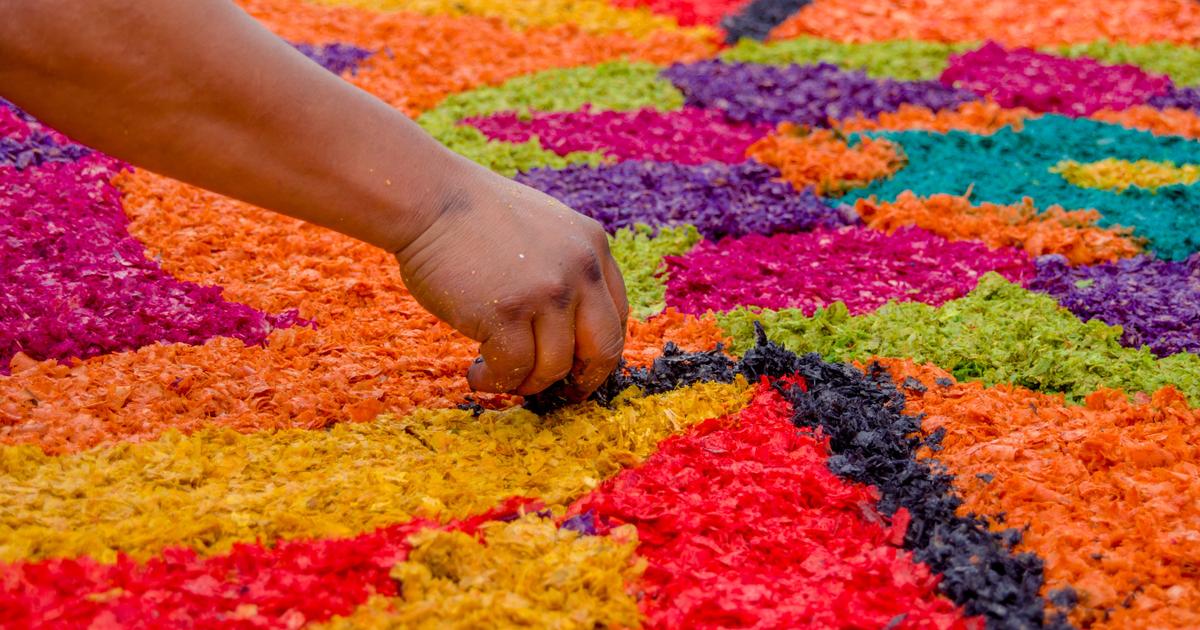Chocolates hidden in the garden, eggs to be painted in all colors… In France, Easter is synonymous with a privileged moment with the family – and, for some, with a liver attack after all those chocolates swallowed.
Overview of the most unusual traditions around the world.
Burning Judas in Latin America
Since 1499, Venezuelans have burned a mannequin believed to represent Judas at Easter.
AdobeStock/LEONIDAS
In the Iberian Peninsula, Latin America and some Central European countries, Easter is associated with fire.
A life-size Judas is recreated, traditionally in the image of an unpopular character (political or not).
Tossed about in the streets, he is insulted by the crowd while awaiting his trial.
A trial whose verdict remains unchanged year after year: the figure of Judas burns tirelessly when Easter comes.
He can also be hit and hanged.
And this tradition is not new: we find the first manifestations of it in Venezuela, as early as 1499.
Read alsoTen spectacular places in South America
Have an egg fight in Greece
At Easter, the Greeks throw themselves heart and soul into a giant egg battle.
AdobeStock/korpithas
In Greece, we don't look for chocolate hens.
We don't paint eggs either.
You throw it at your opponents.
Participants must also protect their egg.
On some islands, such as Corfu, locals even throw 'botides', large clay jugs filled with water, from their balconies.
These crash in great crashes all day long on the ground.
This tradition would aim to repel evil spirits.
Moreover, the curious who attended the show sometimes bring home pieces of broken jugs, which serve as a lucky charm.
...and a giant water fight in Poland
Śmigus-dyngus
.
This is the name of the Polish tradition of organizing a giant water fight in the streets of the country at Easter.
JANEK SKARZYNSKI / AFP
In Poland, Easter is not an egg fight, but a water fight.
In this very Catholic country, the objective is to remind Christian Poles of their baptism and wash away their sins.
Water also symbolizes life and renewal.
This tradition is aptly named: called “Śmigus-dyngus” or “lany poniedziałek”, it means “flooded Monday”.
Originally, “Śmigus-dyngus” also extended to the fields, which the Poles sprinkled with holy water.
Read alsoTravel to Poland, the land of a thousand lakes
Cover the streets of Antigua with carpets of all colors
The Guatemalan city of Antigua installs long multicolored carpets in its streets at Easter.
AdobeStock/adfoto
Antigua, the former capital of the Kingdom of Guatemala in the south of the country, celebrates Easter by lining its streets with colorful rugs during Holy Week.
Religious scenes, relating to the Mayan tradition or to the history of the country are represented there.
And some of these rugs are sometimes up to half a mile long.
If several months can be necessary for the creation of these works, these have a very short lifespan, since the Good Friday processions pass over them.
Read alsoClimb eight volcanoes in Guatemala
Eating a giant omelette in France
The inhabitants of Haux get their hands dirty at Easter.
PATRICK BERNARD / AFP
If the most common dish in France at Easter is chocolate – in all its forms – Haux, a town in the South-West, does not see things that way.
On Easter Monday, the municipality near Bordeaux breaks thousands of eggs to make a giant omelet.
The goal ?
To be able to feed a thousand people thanks to this preparation.
In addition to the giant meal, many activities are offered in Haux, from horse-drawn carriage rides to dances.
Read alsoCycling: three routes to do around Bordeaux
Celebrate Halloween at Easter in Finland
In Finland, Easter rhymes with Halloween.
AdobeStock/Alexander Shalamov
In the land of a thousand lakes, you may come across children dressed up as witches, mummies and other monsters at Easter.
And these will likely be knocking on doors asking for treats.
All while pronouncing a formula supposed to bless the house at which they knocked: “
Virvon, varvon, tuoreeks terveeks, tulevaks vuodeks;
Vitsa sulle, palkka mulle!
".
And waving a willow branch, usually decorated with feathers.
This tradition is believed to ward off evil spirits and ensure a good harvest season.
Read alsoDo you really know the nicknames of the countries you visit?
Read a good thriller in Norway
In Norway, we have our eyes plunged into our favorite thriller at Easter.
AdobeStock/Nightman1965
In the Land of the Midnight Sun, too, the atmosphere is spooky at Easter.
The
Påskekrim
, “Easter crime stories”, are on the rise every year at this time.
Everyone grabs their thriller and leafs through it quietly.
Television channels produce and loop crime series.
The publishers, for their part, publish their “Easter-Thrillers”, Easter thrillers.
The origin of this tradition remains unknown.
Some link her to the director of the Gyldendal publishing house, Harald Grieg, who in 1923 launched a successful advertising campaign around
Bergenstoget plyndret i natt
, a detective novel by Nordahl Grieg and Nils Lie.
All this on the eve of Palm Sunday.

